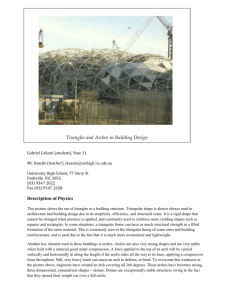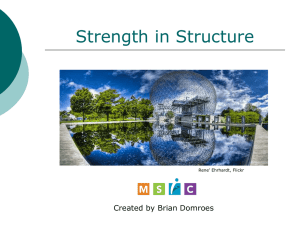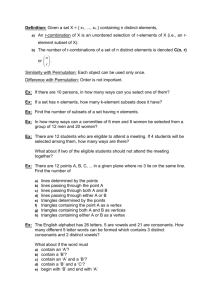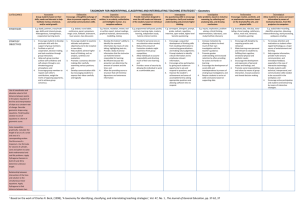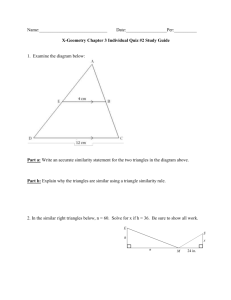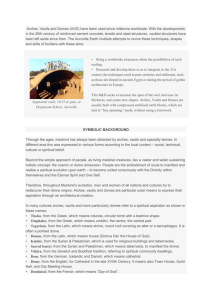The Lesson
advertisement
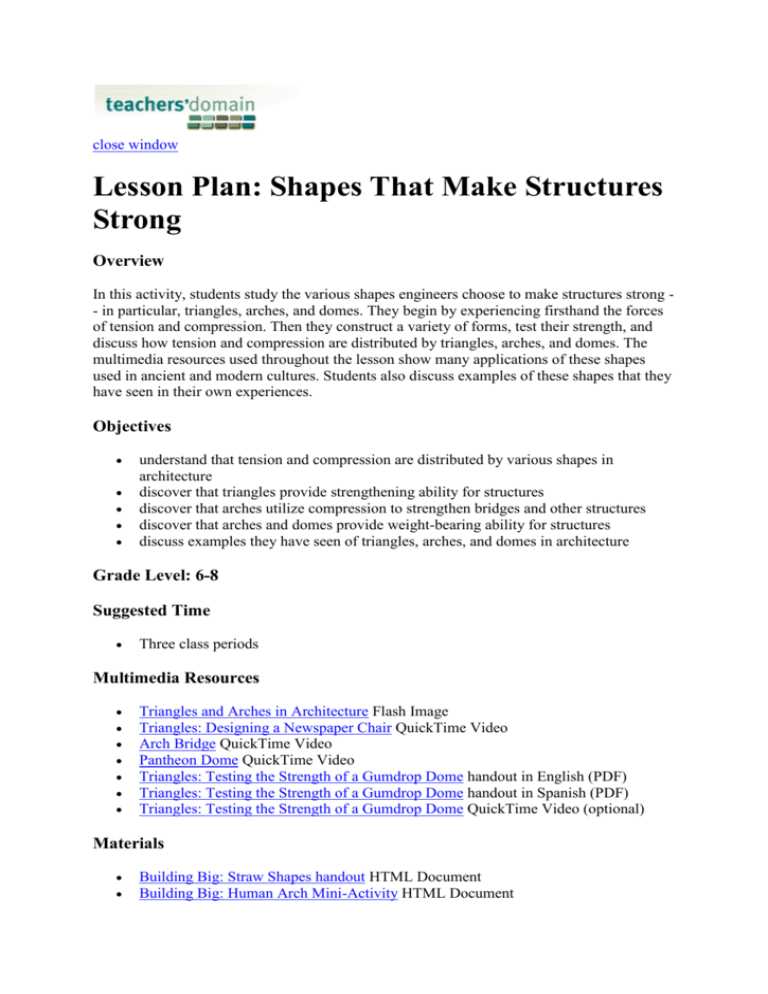
close window Lesson Plan: Shapes That Make Structures Strong Overview In this activity, students study the various shapes engineers choose to make structures strong - in particular, triangles, arches, and domes. They begin by experiencing firsthand the forces of tension and compression. Then they construct a variety of forms, test their strength, and discuss how tension and compression are distributed by triangles, arches, and domes. The multimedia resources used throughout the lesson show many applications of these shapes used in ancient and modern cultures. Students also discuss examples of these shapes that they have seen in their own experiences. Objectives understand that tension and compression are distributed by various shapes in architecture discover that triangles provide strengthening ability for structures discover that arches utilize compression to strengthen bridges and other structures discover that arches and domes provide weight-bearing ability for structures discuss examples they have seen of triangles, arches, and domes in architecture Grade Level: 6-8 Suggested Time Three class periods Multimedia Resources Triangles and Arches in Architecture Flash Image Triangles: Designing a Newspaper Chair QuickTime Video Arch Bridge QuickTime Video Pantheon Dome QuickTime Video Triangles: Testing the Strength of a Gumdrop Dome handout in English (PDF) Triangles: Testing the Strength of a Gumdrop Dome handout in Spanish (PDF) Triangles: Testing the Strength of a Gumdrop Dome QuickTime Video (optional) Materials Building Big: Straw Shapes handout HTML Document Building Big: Human Arch Mini-Activity HTML Document NOVA: Tasty Arch handout HTML Document cream wafer cookies plastic knives sandpaper, medium grit Building Big: Human Dome Mini-Activity HTML Document gumdrops toothpicks Before the Lesson Print copies of the handouts and activities listed under Materials for your students. The Lesson Part I: Compression and Tension 1. Have students work in pairs to experience compression for themselves. Tell student pairs to stand face to face and gently press their palms together at about shoulder height (as in a "high five"). Then tell them to slowly lean into each other. Ask them to describe what they feel, where they feel it, and what they think is causing the feeling. 2. Next, have students experience tension. While standing and facing each other, have student pairs grab hands and gently lean away from each other. Ask them to describe what they feel, where they feel it, and what they think is causing the feeling. 3. Show the Triangles and Arches in Architecture stills collage and discuss the following: Which shapes provide strength to structures? What shapes are used in buildings in your neighborhood? In large cities? In ancient buildings? Is using certain shapes to increase the strength of structures a modern idea? What architectural elements have carried through from ancient to modern cultures? What elements have changed? How do you think these shapes impact the designs that today's engineers and architects choose for buildings? 4. Distribute the Building Big: Straw Shapes handout, drinking straws, and paper clips. Have students work in groups if supplies are short or if you find that teamwork is productive in your class. After students have built their triangles and squares, ask them to identify the areas in each shape that experience tension and compression when a load is placed on top of the shape. Ask them to explain why the triangle is stronger than the square in terms of the distribution of tension and compression. 5. Show the Triangles: Designing a Newspaper Chair video and continue to discuss how triangles help distribute forces such as tension and compression under a load. Part II: Arches 6. Review the Building Big: Human Arch Mini-Activity. Then break the class into groups of four or five students each to do the activity. Have students describe where they feel pushing (compression) and pulling (tension). 7. Show the Arch Bridge video. Discuss how the construction of an ancient arch relates to the forces the students experienced in their human arch. Have students explain why the shape of each rock and the keystone are so vital to the strength and stability of the arch. 8. Distribute the NOVA: Tasty Arch handout, cream wafers, plastic knives, and sandpaper. Have students work in teams to build arches per the instructions. If time permits, have them test the strength of the arches under a load of books. Ask students to explain what forces are exerted on the arch when the book is on top, and how the arch distributes those forces. Part III: Domes 9. Review the Building Big: Human Dome Mini-Activity. Then break the class into groups of 10 students each to do the activity. Have students explain how the dome shape distributes forces to be able to support a heavy load. 10. Show the Pantheon Dome video. Discuss how ancient cultures used certain shapes to support heavy loads. Have students explain where additional mass must be placed on a dome to increase support, and where mass can be removed to lighten the load. 11. Distribute the Triangles: Testing the Strength of a Gumdrop Dome handout (in English and/or Spanish), gumdrops, and toothpicks. Have students work alone or in teams to build domes per the instructions. If time permits, have students test the strength of the domes under a load of books. Ask students to explain what forces are exerted on the dome when the book is on top, and how the triangle shapes within the dome distribute those forces. If it is too difficult to balance a load of books on a single dome, have students devise a different method to test the strength of a dome. If making the domes is not feasible, have students watch the Triangles: Testing the Strength of a Gumdrop Dome video. Check for Understanding Have students discuss the following, using sketches and arrows wherever possible: Explain the reasons why triangles, arches, and domes are used to increase the strength of structures. Give examples from the multimedia resources you have used. Explain how the architectural lessons learned from ancient cultures have affected the engineering and construction of today's buildings. Have students draw a triangle, an arch, and a dome. Tell them to use arrows to show the direction of tension and compression when a load is placed on top of each shape.
